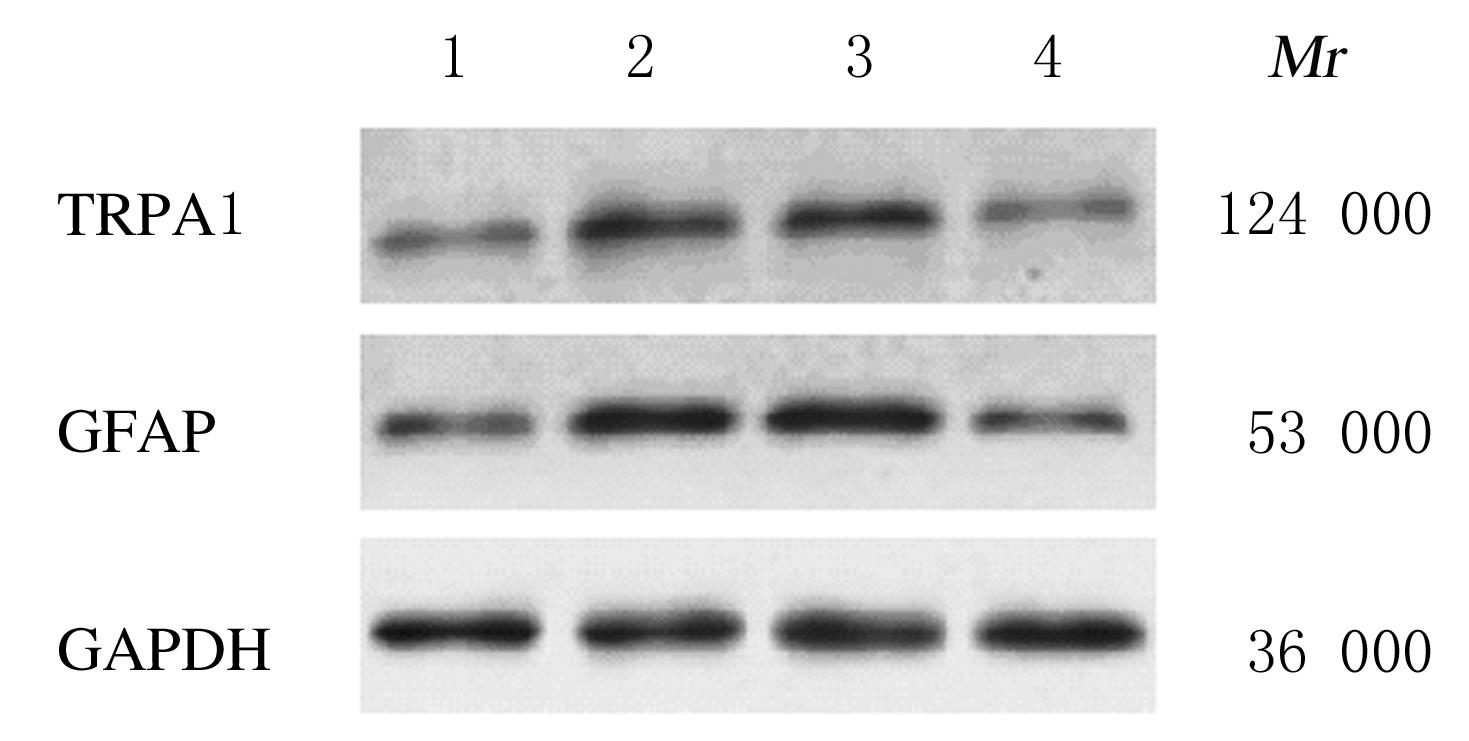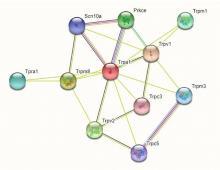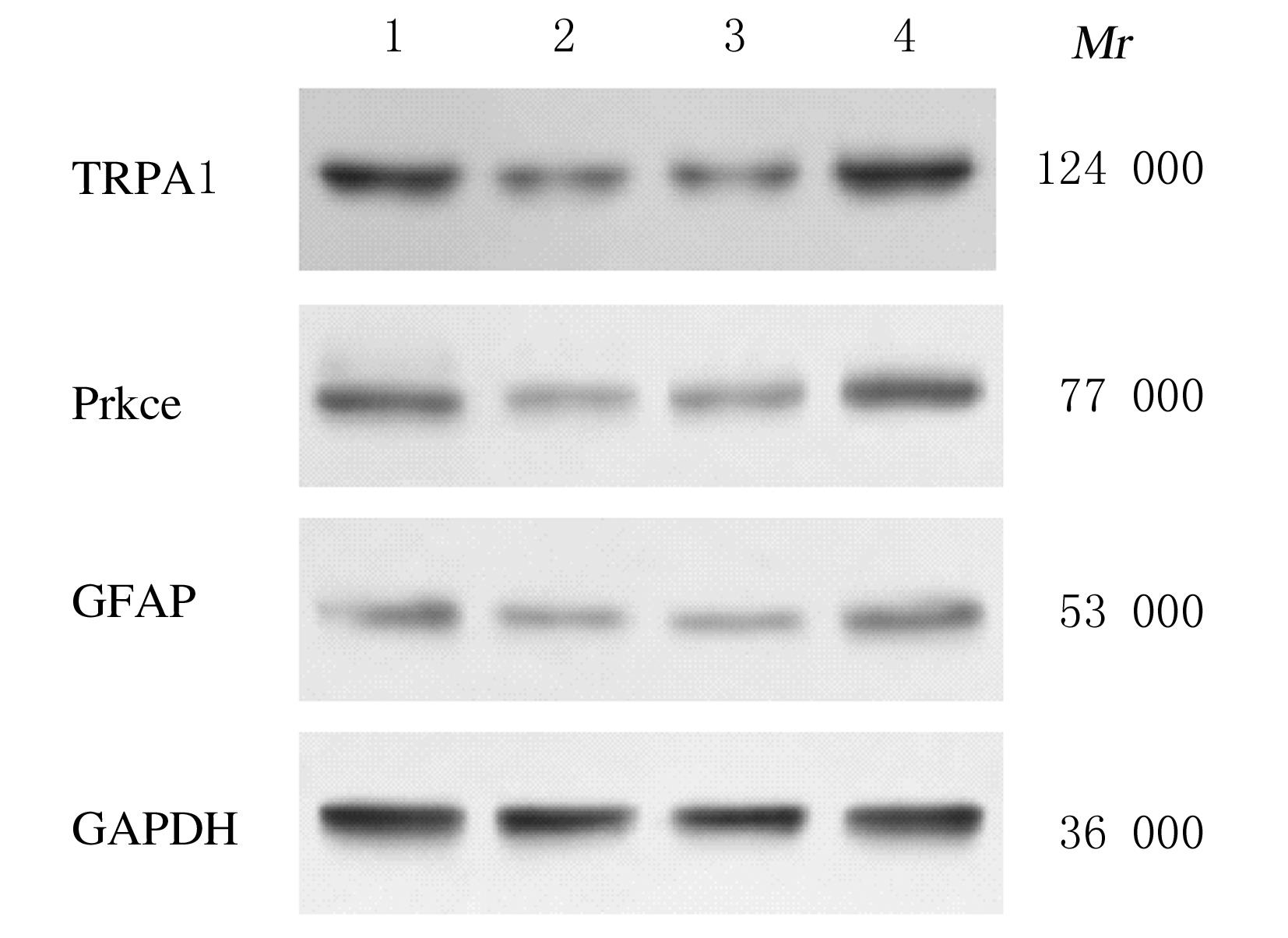Journal of Jilin University(Medicine Edition) ›› 2021, Vol. 47 ›› Issue (6): 1485-1494.doi: 10.13481/j.1671-587X.20210619
• Research in basic medicine • Previous Articles Next Articles
Effect of intrathecal injection of transient receptor potential cation channel subfamily A member 1 shRNA on neuropathic pain in mice with partial sciatic nerve ligation and its mechanism
Feng ZHAO1( ),Shaoqing FAN1,Xiaoyan CHENG1,Xiaona LI1,Changsheng LI2,Haojie MA1
),Shaoqing FAN1,Xiaoyan CHENG1,Xiaona LI1,Changsheng LI2,Haojie MA1
- 1.Department of Anesthesiology,Henan Province Hospital of Traditional Chinese Medicine,Zhengzhou 450002,China
2.Department of Anesthesiology and Perioperative Medicine,Henan Cancer Hospital,Zhengzhou 450003,China
-
Received:2021-02-01Online:2021-11-28Published:2021-12-14 -
Contact:Feng ZHAO E-mail:lmlm20@163.com
CLC Number:
- R741
Cite this article
Feng ZHAO,Shaoqing FAN,Xiaoyan CHENG,Xiaona LI,Changsheng LI,Haojie MA. Effect of intrathecal injection of transient receptor potential cation channel subfamily A member 1 shRNA on neuropathic pain in mice with partial sciatic nerve ligation and its mechanism[J].Journal of Jilin University(Medicine Edition), 2021, 47(6): 1485-1494.
share this article
Tab.1
MWT of mice in various groups"
| Group | MWT | ||||
|---|---|---|---|---|---|
| Before injection | 1 h after injection | 7 h after injection | 12 h after injection | 24 h after injection | |
| Control | 11.51±0.80 | 11.70±0.21 | 11.06±0.45 | 10.81±0.35 | 11.62±0.34 |
| Sham operation | 11.20±0.68 | 11.82±0.25 | 10.80±0.31 | 11.22±0.43 | 11.31±0.14 |
| pSNL | 5.62±0.33* | 5.53±0.25* | 5.72±0.13* | 5.51±0.32** | 4.84±0.69* |
| pSNL+NC shRNA | 5.82±0.42* | 5.73±0.33* | 5.52±0.43* | 5.81±0.63** | 4.55±0.38* |
| pSNL+TRPA1 shRNA | 5.53±0.28* | 9.31±0.13*△# | 10.22±0.42△# | 10.73±0.48△# | 10.90±0.13△# |
Tab. 2
TWL of mice in various groups"
| Group | TWL | ||||
|---|---|---|---|---|---|
| Before injection | 1 h after injection | 7 h after injection | 12 h after injection | 24 h after injection | |
| Control | 18.52±0.90 | 17.71±0.19 | 17.20±0.25 | 16.83±0.51 | 17.64±0.43 |
| Sham operation | 18.20±0.76 | 17.81±0.65 | 17.80±0.11 | 17.22±0.46 | 18.03±0.12 |
| pSNL | 11.04±0.22* | 10.91±0.12* | 10.33±0.35* | 10.52±0.65* | 8.73±0.52* |
| pSNL+NC shRNA | 10.81±0.32* | 10.74±0.31* | 10.40±0.53* | 10.31±0.53* | 8.53±0.34* |
| pSNL+TRPA1 shRNA | 10.50±0.18* | 16.33±0.23* | 16.52±0.51*△# | 16.81±0.55△# | 17.63±0.63△# |
| 1 | POPIOLEK-BARCZYK K, MIKA J. Targeting the microglial signaling pathways: new insights in the modulation of neuropathic pain[J]. Curr Med Chem, 2016, 23(26): 2908-2928. |
| 2 | ZHAO B S, PAN Y Y, XU H P, et al. Kindlin-1 regulates astrocyte activation and pain sensitivity in rats with neuropathic pain[J]. Reg Anesth Pain Med, 2018, 43(5): 547-553. |
| 3 | MARWAHA L, BANSAL Y, SINGH R, et al. TRP channels: potential drug target for neuropathic pain[J]. Inflammopharmacology, 2016, 24(6): 305-317. |
| 4 | HUANG K, BIAN D L, JIANG B, et al. TRPA1 contributed to the neuropathic pain induced by docetaxel treatment[J].Cell Biochem Funct,2017,35(3): 141-143. |
| 5 | SAŁAT K, FILIPEK B. Antinociceptive activity of transient receptor potential channel TRPV1, TRPA1, and TRPM8 antagonists in neurogenic and neuropathic pain models in mice[J]. J Zhejiang Univ Sci B, 2015, 16(3): 167-178. |
| 6 | LEE K I, LIN H C, LEE H T, et al. Loss of transient receptor potential ankyrin 1 channel deregulates emotion, learning and memory, cognition, and social behavior in mice[J]. Mol Neurobiol, 2017, 54(5): 3606-3617. |
| 7 | 张 俊, 宋必卫. 瞬时受体电位通道在疼痛中作用的研究进展[J]. 中国药理学与毒理学杂志, 2018, 32(8): 644-650. |
| 8 | JENSEN T S, FINNERUP N B. Allodynia and hyperalgesia in neuropathic pain: clinical manifestations and mechanisms[J]. Lancet Neurol, 2014, 13(9): 924-935. |
| 9 | TSUDA M. Modulation of pain and itch by spinal glia[J]. Neurosci Bull, 2018, 34(1): 178-185. |
| 10 | LU Y, JIANG B C, CAO D L, et al. TRAF6 upregulation in spinal astrocytes maintains neuropathic pain by integrating TNF-α and IL-1β signaling[J]. Pain, 2014, 155(12): 2618-2629. |
| 11 | CHEN H, HU Y, XIE K, et al. Effect of autophagy on allodynia, hyperalgesia and astrocyte activation in a rat model of neuropathic pain[J]. Int J Mol Med, 2018, 42(4): 2009-2019. |
| 12 | HANSEN R R, MALCANGIO M. Astrocytes: multitaskers in chronic pain[J]. Eur J Pharmacol, 2013, 716(1-3): 120-128. |
| 13 | TSUDA M. Astrocytes in the spinal dorsal horn and chronic itch[J]. Neurosci Res, 2018, 126: 9-14. |
| 14 | EID S R, CROWN E D, MOORE E L, et al. HC-030031, a TRPA1 selective antagonist, attenuates inflammatory-and neuropathy-induced mechanical hypersensitivity[J]. Mol Pain, 2008, 4: 48. |
| 15 | 吕 品, 闫明超, 谈安棋, 等. 瞬时受体电位通道A1在神经病理性疼痛机制中的研究进展[J]. 国际麻醉学与复苏杂志, 2019, 40(4): 388-392. |
| 16 | MIYAKAWA T, TERASHIMA Y, TAKEBAYASHI T, et al. Transient receptor potential ankyrin 1 in spinal cord dorsal horn is involved in neuropathic pain in nerve root constriction rats[J]. Mol Pain, 2014, 10: 58. |
| 17 | KASHIWADANI H, HIGA Y, SUGIMURA M,et al. Linalool odor-induced analgesia is triggered by TRPA1-independent pathway in mice[J]. Behav Brain Funct, 2021, 17(1): 3. |
| 18 | KANDA H, YANG Y J, DUAN S Q, et al. Atractylodin produces antinociceptive effect through a long-lasting TRPA1 channel activation[J]. Int J Mol Sci, 2021, 22(7): 3614. |
| 19 | DOMBI Á, SÁNTA C, BÁTAI I Z, et al. Dimethyl trisulfide diminishes traumatic neuropathic pain acting on TRPA1 receptors in mice[J]. Int J Mol Sci, 2021, 22(7): 3363. |
| 20 | ZHANG H, CHEN H. TRPA1 involved in miR-141-5p-alleviated neuropathic pain induced by oxaliplatin[J]. Neuroreport, 2021, 32(3): 284-290. |
| 21 | AKITA Y. Protein kinase C-ε (PKC-ε): its unique structure and function[J]. J Biochem, 2002, 132(6): 847-852. |
| 22 | AKITA Y. Protein kinase Cepsilon: multiple roles in the function of, and signaling mediated by the cytoskeleton[J]. Febs J, 2008, 275(16): 3995-4004. |
| 23 | WU D F, CHANDRA D, MCMAHON T, et al. PKCε phosphorylation of the sodium channel NaV1.8 increases channel function and produces mechanical hyperalgesia in mice[J]. J Clin Invest, 2012, 122(4): 1306-1315. |
| 24 | ZHAO X T, XIA B B, CHENG J K, et al. PKCε SUMOylation is required for mediating the nociceptive signaling of inflammatory pain[J].Cell Rep,2020,33(1):108191. |
| 25 | 张 杨, 杜占慧, 魏 慧, 等. 蛋白激酶Cε对大鼠背根神经节持续受压后背角星型胶质细胞激活和机械痛敏的影响[J]. 中国康复医学杂志, 2019, 34(11): 1278-1284. |
| 26 | LIU X Y, BAI H, WU X, et al. Recombinant adiponectin inhibits the expression of inflammation-associated proteins from mouse astrocytes via AMPK-independent PKC pathway[J]. Xi Bao Yu Fen Zi Mian Yi Xue Za Zhi, 2020, 36(7): 596-602. |
| 27 | CAO S, LI Q, HOU J, et al. Intrathecal TRPM8 blocking attenuates cold hyperalgesia via PKC and NF-κB signaling in the dorsal root ganglion of rats with neuropathic pain[J]. J Pain Res, 2019, 12: 1287-1296. |
| 28 | CHOI S R, HAN H J, BEITZ A J, et al. nNOS-PSD95 interactions activate the PKC-ε isoform leading to increased GluN1 phosphorylation and the development of neuropathic mechanical allodynia in mice[J]. Neurosci Lett, 2019, 703: 156-161. |
| [1] | Xiaohua LIU,Bingying FANG,Man HAN,Haifa QIAO,Yuanwang YU. Analgesic effect of baicalein on neuropathic pain of rats and its mechanism [J]. Journal of Jilin University(Medicine Edition), 2022, 48(3): 600-605. |
| [2] | Zehua GONG,Junjie LIU,Jiwei XU,Jianmin LI. Effects of ceftriaxone on activation of astrocytes and inflammation reaction in rats with subarachnoid hemorrhage [J]. Journal of Jilin University(Medicine Edition), 2021, 47(6): 1462-1468. |
| [3] | Qi LIU,Xianchen ZHANG,Xiangyu LI,Yumiao LIN,Yanqi YANG,Enzhi YAN. Inhibitory effect of lithium chloride on Aβ1-42-induced astrocyte glutamate release and its protective effect on hippocampal neuronal injury [J]. Journal of Jilin University(Medicine Edition), 2021, 47(1): 35-43. |
| [4] | Chongjun XU,Hefan HE,Qun LIN,Tao ZHANG. Construction of human hepatocyte growth factor gene lentivirus vector and its expression in bone marrow mesenchymal stem cells [J]. Journal of Jilin University(Medicine Edition), 2021, 47(1): 16-24. |
| [5] | PEI Dan, LIU Xue. Effect of inhibition of PDGFRα activation on glial cell proliferation and scar formation after brain injury in mice [J]. Journal of Jilin University(Medicine Edition), 2020, 46(05): 1023-1028. |
| [6] | JIANG Ren, FENG Zhiying, LI Ping, LI Hong, LI Shuangyue. Effect of sciatic nervepulsed radiofrequency glial activation levels in spinal dorsal horn in chronic constriction injury rat models and its analgesia effect [J]. Journal of Jilin University(Medicine Edition), 2019, 45(01): 45-50. |
| [7] | LIU Linna, CHEN Jieyu, LYU Fangyi, HUA Kouzhen, CAI Damin, YIN Guoli, WANG Junjuan. Effect of fingolimod on proliferation and migration of neural stem cells and astrocytes and its protective mechanism against spinal cord injury in mice [J]. Journal of Jilin University(Medicine Edition), 2018, 44(06): 1218-1222. |
| [8] | MA Li-na, YU Hong-mei,ZHAO Wen-jing, LUO Tao, CHEN Sen, NOMOTO Hiroshi, FURUKAWA Shoei. Construction and identification of astrocyte linesexpressing NGF, BDNF, and NT3 steadily [J]. J4, 2005, 31(2): 227-230. |
| [9] | MA Li-na, ZHAO Wen-jing, LUO Tao, NOMOTO Hiroshi,FURUKAWA Shoei. Establishment of culture system of conditionalizationfor astrocytes of cerebral cortex in vitro [J]. J4, 2004, 30(5): 727-729. |
| [10] | LI Xian-hui, CHENG Yi, LIU Ya-wen , WANG Gang, LI Ji-sheng. Expression of nerve growth factor gene in astrocytescultured in 1,25-(OH)2D3 defined medium [J]. J4, 2004, 30(3): 398-400. |























